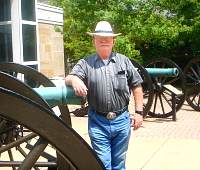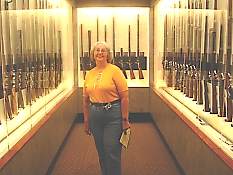Chickamauga
And the Battle for Chattanooga
Chattanooga, TN
May 16th, 2006
As  we
have traveled through the U.S. I have taken special interest in what some have
called “The greatest war America ever fought”.
The Civil War, or War between the States or the War of Succession
1861-1865. It was fought, for the
most part, in the southern half of the U.S.
Now parked outside Chattanooga, TN., I had a chance to continue my inquires
into those events, with a visit to the Chickamauga and Lookout Mountain
battlefields.
we
have traveled through the U.S. I have taken special interest in what some have
called “The greatest war America ever fought”.
The Civil War, or War between the States or the War of Succession
1861-1865. It was fought, for the
most part, in the southern half of the U.S.
Now parked outside Chattanooga, TN., I had a chance to continue my inquires
into those events, with a visit to the Chickamauga and Lookout Mountain
battlefields.
In
1862 war had not yet touched everybody in the country, as it eventually would. Union forces were advancing from the north
through Tennessee in an attempt to split the state. The battle of Shiloh near
Murfreesboro some 80 miles northwest saw the Confederate army retreating east.
For the next 90 days the Confederates skirmished with the Union. Chattanooga was
a rail hub that was capable of supplying both the North and South with needed
war material. Control of the city was vital. During the summer, the Union Army,
commanded by General William S. Rosecrans conducted brilliant flanking maneuvers
that forced the Confederate defenders, commanded by General Braxton Bragg, to
abandon Middle Tennessee, taking up residency in Chattanooga. Then the
Northerners accomplished the near impossible, crossing the rugged mountainous
wilderness west of Chattanooga and arriving undetected at the outskirts to the
city. Taken
by surprise, the befuddled Confederates evacuated the town without firing a
shot. All was not lost, however, as heavy reinforcements from Mississippi and Alabama
arrived in the nick of time, reinforcing the retreating Confederate force which
were gathering at LaFayette, Ga.
Eventually Bragg would gather over 66,000 men.
country, as it eventually would. Union forces were advancing from the north
through Tennessee in an attempt to split the state. The battle of Shiloh near
Murfreesboro some 80 miles northwest saw the Confederate army retreating east.
For the next 90 days the Confederates skirmished with the Union. Chattanooga was
a rail hub that was capable of supplying both the North and South with needed
war material. Control of the city was vital. During the summer, the Union Army,
commanded by General William S. Rosecrans conducted brilliant flanking maneuvers
that forced the Confederate defenders, commanded by General Braxton Bragg, to
abandon Middle Tennessee, taking up residency in Chattanooga. Then the
Northerners accomplished the near impossible, crossing the rugged mountainous
wilderness west of Chattanooga and arriving undetected at the outskirts to the
city. Taken
by surprise, the befuddled Confederates evacuated the town without firing a
shot. All was not lost, however, as heavy reinforcements from Mississippi and Alabama
arrived in the nick of time, reinforcing the retreating Confederate force which
were gathering at LaFayette, Ga.
Eventually Bragg would gather over 66,000 men.
We started with the Chickamauga
battlefield, located in Fort Oglethorpe, GA., stopping at the Visitor Center on the North side of the park.
The Natio nal Park, which encompasses the entire battlefield, is one of
the 4 original National Military Parks, sharing the honor with Shiloh,
Gettysburg and Vicksburg National Parks. They
were created by act of Congress in 1890, and placed in the hands of the Army
until turned over to the National Park Service in 1933. The two-story glass
entrance to the Center is ceremonially defended by a series of cannon
representing one of each of the type used in the conflict.
I paused for a moment in front of an old 12 pound James rifled
nal Park, which encompasses the entire battlefield, is one of
the 4 original National Military Parks, sharing the honor with Shiloh,
Gettysburg and Vicksburg National Parks. They
were created by act of Congress in 1890, and placed in the hands of the Army
until turned over to the National Park Service in 1933. The two-story glass
entrance to the Center is ceremonially defended by a series of cannon
representing one of each of the type used in the conflict.
I paused for a moment in front of an old 12 pound James rifled cannon.
This display was but one of the 1400 original monuments and historical markers
placed on the battlefield. Upon entering, we learned that the 26 minute film
depicting the battle was temporarily out of service. Although disappointed, we found another attraction.
This was one of the finest collections of vintage flintlock and
percussion muskets. Most weapons
created prior to the Civil War were hand made and labor intensive.
As such, there were quite a variety of weapons and a considerable
assortment of manufacturers. This collection included some of the rarely seen
specialty muskets. I found one I
had only heard about. Called the
“coffee grinder”, it actually had a coffee grinder built into the butt of
the weapon.
cannon.
This display was but one of the 1400 original monuments and historical markers
placed on the battlefield. Upon entering, we learned that the 26 minute film
depicting the battle was temporarily out of service. Although disappointed, we found another attraction.
This was one of the finest collections of vintage flintlock and
percussion muskets. Most weapons
created prior to the Civil War were hand made and labor intensive.
As such, there were quite a variety of weapons and a considerable
assortment of manufacturers. This collection included some of the rarely seen
specialty muskets. I found one I
had only heard about. Called the
“coffee grinder”, it actually had a coffee grinder built into the butt of
the weapon.
 <<<<< Back
<<<<< Back